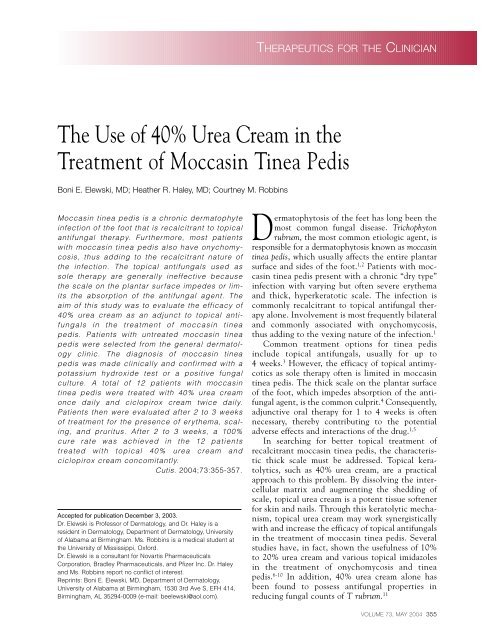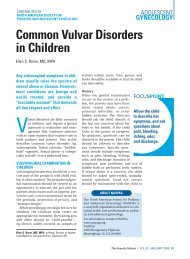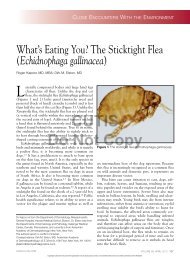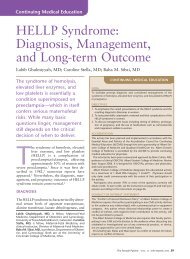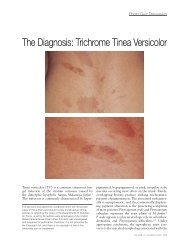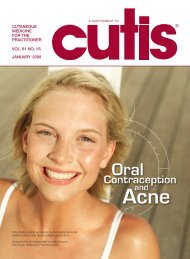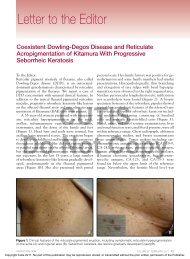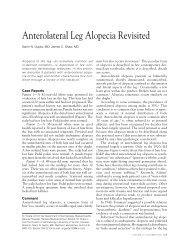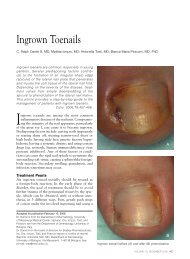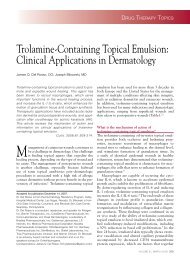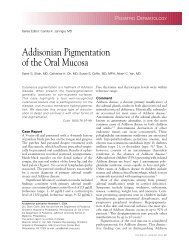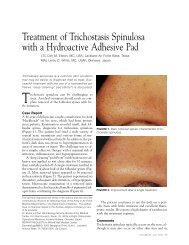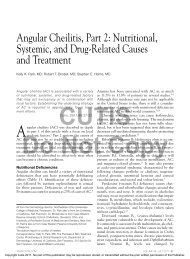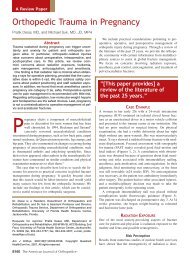The Use of 40% Urea Cream in the Treatment of Moccasin ... - Cutis
The Use of 40% Urea Cream in the Treatment of Moccasin ... - Cutis
The Use of 40% Urea Cream in the Treatment of Moccasin ... - Cutis
Create successful ePaper yourself
Turn your PDF publications into a flip-book with our unique Google optimized e-Paper software.
THERAPEUTICS FOR THE CLINICIAN<br />
<strong>The</strong> <strong>Use</strong> <strong>of</strong> <strong>40%</strong> <strong>Urea</strong> <strong>Cream</strong> <strong>in</strong> <strong>the</strong><br />
<strong>Treatment</strong> <strong>of</strong> Moccas<strong>in</strong> T<strong>in</strong>ea Pedis<br />
Boni E. Elewski, MD; Hea<strong>the</strong>r R. Haley, MD; Courtney M. Robb<strong>in</strong>s<br />
Moccas<strong>in</strong> t<strong>in</strong>ea pedis is a chronic dermatophyte<br />
<strong>in</strong>fection <strong>of</strong> <strong>the</strong> foot that is recalcitrant to topical<br />
antifungal <strong>the</strong>rapy. Fur<strong>the</strong>rmore, most patients<br />
with moccas<strong>in</strong> t<strong>in</strong>ea pedis also have onychomycosis,<br />
thus add<strong>in</strong>g to <strong>the</strong> recalcitrant nature <strong>of</strong><br />
<strong>the</strong> <strong>in</strong>fection. <strong>The</strong> topical antifungals used as<br />
sole <strong>the</strong>rapy are generally <strong>in</strong>effective because<br />
<strong>the</strong> scale on <strong>the</strong> plantar surface impedes or limits<br />
<strong>the</strong> absorption <strong>of</strong> <strong>the</strong> antifungal agent. <strong>The</strong><br />
aim <strong>of</strong> this study was to evaluate <strong>the</strong> efficacy <strong>of</strong><br />
<strong>40%</strong> urea cream as an adjunct to topical antifungals<br />
<strong>in</strong> <strong>the</strong> treatment <strong>of</strong> moccas<strong>in</strong> t<strong>in</strong>ea<br />
pedis. Patients with untreated moccas<strong>in</strong> t<strong>in</strong>ea<br />
pedis were selected from <strong>the</strong> general dermatology<br />
cl<strong>in</strong>ic. <strong>The</strong> diagnosis <strong>of</strong> moccas<strong>in</strong> t<strong>in</strong>ea<br />
pedis was made cl<strong>in</strong>ically and confirmed with a<br />
potassium hydroxide test or a positive fungal<br />
culture. A total <strong>of</strong> 12 patients with moccas<strong>in</strong><br />
t<strong>in</strong>ea pedis were treated with <strong>40%</strong> urea cream<br />
once daily and ciclopirox cream twice daily.<br />
Patients <strong>the</strong>n were evaluated after 2 to 3 weeks<br />
<strong>of</strong> treatment for <strong>the</strong> presence <strong>of</strong> ery<strong>the</strong>ma, scal<strong>in</strong>g,<br />
and pruritus. After 2 to 3 weeks, a 100%<br />
cure rate was achieved <strong>in</strong> <strong>the</strong> 12 patients<br />
treated with topical <strong>40%</strong> urea cream and<br />
ciclopirox cream concomitantly.<br />
<strong>Cutis</strong>. 2004;73:355-357.<br />
Accepted for publication December 3, 2003.<br />
Dr. Elewski is Pr<strong>of</strong>essor <strong>of</strong> Dermatology, and Dr. Haley is a<br />
resident <strong>in</strong> Dermatology, Department <strong>of</strong> Dermatology, University<br />
<strong>of</strong> Alabama at Birm<strong>in</strong>gham. Ms. Robb<strong>in</strong>s is a medical student at<br />
<strong>the</strong> University <strong>of</strong> Mississippi, Oxford.<br />
Dr. Elewski is a consultant for Novartis Pharmaceuticals<br />
Corporation, Bradley Pharmaceuticals, and Pfizer Inc. Dr. Haley<br />
and Ms. Robb<strong>in</strong>s report no conflict <strong>of</strong> <strong>in</strong>terest.<br />
Repr<strong>in</strong>ts: Boni E. Elewski, MD, Department <strong>of</strong> Dermatology,<br />
University <strong>of</strong> Alabama at Birm<strong>in</strong>gham, 1530 3rd Ave S, EFH 414,<br />
Birm<strong>in</strong>gham, AL 35294-0009 (e-mail: beelewski@aol.com).<br />
Dermatophytosis <strong>of</strong> <strong>the</strong> feet has long been <strong>the</strong><br />
most common fungal disease. Trichophyton<br />
rubrum, <strong>the</strong> most common etiologic agent, is<br />
responsible for a dermatophytosis known as moccas<strong>in</strong><br />
t<strong>in</strong>ea pedis, which usually affects <strong>the</strong> entire plantar<br />
surface and sides <strong>of</strong> <strong>the</strong> foot. 1,2 Patients with moccas<strong>in</strong><br />
t<strong>in</strong>ea pedis present with a chronic “dry type”<br />
<strong>in</strong>fection with vary<strong>in</strong>g but <strong>of</strong>ten severe ery<strong>the</strong>ma<br />
and thick, hyperkeratotic scale. <strong>The</strong> <strong>in</strong>fection is<br />
commonly recalcitrant to topical antifungal <strong>the</strong>rapy<br />
alone. Involvement is most frequently bilateral<br />
and commonly associated with onychomycosis,<br />
thus add<strong>in</strong>g to <strong>the</strong> vex<strong>in</strong>g nature <strong>of</strong> <strong>the</strong> <strong>in</strong>fection. 1<br />
Common treatment options for t<strong>in</strong>ea pedis<br />
<strong>in</strong>clude topical antifungals, usually for up to<br />
4 weeks. 3 However, <strong>the</strong> efficacy <strong>of</strong> topical antimycotics<br />
as sole <strong>the</strong>rapy <strong>of</strong>ten is limited <strong>in</strong> moccas<strong>in</strong><br />
t<strong>in</strong>ea pedis. <strong>The</strong> thick scale on <strong>the</strong> plantar surface<br />
<strong>of</strong> <strong>the</strong> foot, which impedes absorption <strong>of</strong> <strong>the</strong> antifungal<br />
agent, is <strong>the</strong> common culprit. 4 Consequently,<br />
adjunctive oral <strong>the</strong>rapy for 1 to 4 weeks is <strong>of</strong>ten<br />
necessary, <strong>the</strong>reby contribut<strong>in</strong>g to <strong>the</strong> potential<br />
adverse effects and <strong>in</strong>teractions <strong>of</strong> <strong>the</strong> drug. 1,5<br />
In search<strong>in</strong>g for better topical treatment <strong>of</strong><br />
recalcitrant moccas<strong>in</strong> t<strong>in</strong>ea pedis, <strong>the</strong> characteristic<br />
thick scale must be addressed. Topical keratolytics,<br />
such as <strong>40%</strong> urea cream, are a practical<br />
approach to this problem. By dissolv<strong>in</strong>g <strong>the</strong> <strong>in</strong>tercellular<br />
matrix and augment<strong>in</strong>g <strong>the</strong> shedd<strong>in</strong>g <strong>of</strong><br />
scale, topical urea cream is a potent tissue s<strong>of</strong>tener<br />
for sk<strong>in</strong> and nails. Through this keratolytic mechanism,<br />
topical urea cream may work synergistically<br />
with and <strong>in</strong>crease <strong>the</strong> efficacy <strong>of</strong> topical antifungals<br />
<strong>in</strong> <strong>the</strong> treatment <strong>of</strong> moccas<strong>in</strong> t<strong>in</strong>ea pedis. Several<br />
studies have, <strong>in</strong> fact, shown <strong>the</strong> usefulness <strong>of</strong> 10%<br />
to 20% urea cream and various topical imidazoles<br />
<strong>in</strong> <strong>the</strong> treatment <strong>of</strong> onychomycosis and t<strong>in</strong>ea<br />
pedis. 6-10 In addition, <strong>40%</strong> urea cream alone has<br />
been found to possess antifungal properties <strong>in</strong><br />
reduc<strong>in</strong>g fungal counts <strong>of</strong> T rubrum. 11<br />
VOLUME 73, MAY 2004 355
<strong>The</strong>rapeutics for <strong>the</strong> Cl<strong>in</strong>ician<br />
In Vitro Activity <strong>of</strong> <strong>40%</strong> <strong>Urea</strong> <strong>Cream</strong> and<br />
Ciclopirox <strong>Cream</strong> Aga<strong>in</strong>st Trichophyton rubrum 11<br />
Count After Count After Count After Count After<br />
Control 2 Hours 6 Hours 24 Hours 3 Days<br />
Sample Count (% reduction) (% reduction) (% reduction) (% reduction)<br />
<strong>40%</strong> <strong>Urea</strong> 3.9510 5 2.510 4 (93.6) 1.810 3 (99.5) 7.010 3 (98.2) 10 (99.9)<br />
Ciclopirox 3.9510 5 4.510 5 (0.0) 7.010 5 (0.0) 3.510 4 (91.0) 10 (99.9)<br />
<strong>40%</strong> <strong>Urea</strong> <br />
Ciclopirox 3.9510 5 5.510 2 (99.8) 10 (99.9) 10 (99.9) 10 (99.9)<br />
Topical ciclopirox is a syn<strong>the</strong>tic broad-spectrum<br />
antimycotic agent with <strong>in</strong>hibitory activity aga<strong>in</strong>st<br />
pathogenic dermatophytes, <strong>in</strong>clud<strong>in</strong>g T rubrum. In<br />
addition to be<strong>in</strong>g effective <strong>in</strong> cur<strong>in</strong>g t<strong>in</strong>ea pedis, it<br />
is generally well tolerated. Most reported side<br />
effects (eg, mild pruritus and burn<strong>in</strong>g) are m<strong>in</strong>or<br />
and localized. 12<br />
<strong>The</strong> objective <strong>of</strong> <strong>the</strong> present study was to evaluate<br />
<strong>the</strong> efficacy <strong>of</strong> <strong>40%</strong> urea cream as an adjunct to<br />
topical antifungals <strong>in</strong> <strong>the</strong> treatment <strong>of</strong> recalcitrant<br />
moccas<strong>in</strong> t<strong>in</strong>ea pedis. With its low adverse effect<br />
pr<strong>of</strong>ile, broad-spectrum coverage, and large quantity<br />
available to adequately last for one month,<br />
ciclopirox cream was chosen for study <strong>in</strong> conjunction<br />
with <strong>40%</strong> urea cream.<br />
Methods<br />
Patients with previously untreated moccas<strong>in</strong> t<strong>in</strong>ea<br />
pedis were selected from <strong>the</strong> general dermatology<br />
cl<strong>in</strong>ic. <strong>The</strong> diagnosis <strong>of</strong> moccas<strong>in</strong> t<strong>in</strong>ea pedis was<br />
made cl<strong>in</strong>ically and confirmed with ei<strong>the</strong>r a potassium<br />
hydroxide test from sk<strong>in</strong> scrap<strong>in</strong>gs reveal<strong>in</strong>g<br />
septate hyphae or a positive fungal culture show<strong>in</strong>g<br />
dermatophyte. At basel<strong>in</strong>e, all patients had thick<br />
scale on <strong>the</strong> plantar surfaces <strong>of</strong> <strong>the</strong>ir feet. Some<br />
patients also had dry, red, scaly toe web spaces, and<br />
most patients also had onychomycosis. A total <strong>of</strong><br />
12 patients were treated with a comb<strong>in</strong>ation <strong>of</strong><br />
<strong>40%</strong> urea cream and ciclopirox cream. <strong>The</strong> <strong>40%</strong><br />
urea cream was applied once daily and <strong>the</strong><br />
ciclopirox cream twice daily. After 2 to 3 weeks <strong>of</strong><br />
treatment, patients were evaluated for <strong>the</strong> presence<br />
<strong>of</strong> ery<strong>the</strong>ma, scal<strong>in</strong>g, and pruritus.<br />
Results<br />
A positive fungal culture was obta<strong>in</strong>ed <strong>in</strong> 9 <strong>of</strong> <strong>the</strong><br />
12 patients. T rubrum was isolated <strong>in</strong> 8 patients, and<br />
Epidermophyton floccosum was isolated <strong>in</strong> 1 patient.<br />
On a potassium hydroxide test, septate hyphae were<br />
diagnosed <strong>in</strong> <strong>the</strong> o<strong>the</strong>r 3 patients. Of <strong>the</strong> 12 patients<br />
with moccas<strong>in</strong> t<strong>in</strong>ea pedis treated concomitantly with<br />
topical <strong>40%</strong> urea cream and ciclopirox cream, a 100%<br />
cure rate was achieved. After 2 to 3 weeks <strong>of</strong> comb<strong>in</strong>ation<br />
<strong>the</strong>rapy, all patients were free <strong>of</strong> ery<strong>the</strong>ma,<br />
scal<strong>in</strong>g, and pruritus. In comparison, one patient with<br />
documented T rubrum used a topical antifungal agent<br />
only for one month. This patient had resolution <strong>of</strong><br />
most <strong>of</strong> <strong>the</strong> pruritus but cont<strong>in</strong>ued to compla<strong>in</strong> <strong>of</strong><br />
scal<strong>in</strong>g on <strong>the</strong> feet. By add<strong>in</strong>g <strong>40%</strong> urea cream, <strong>the</strong><br />
scal<strong>in</strong>g was cleared. All patients completed <strong>the</strong> full<br />
course <strong>of</strong> treatment. One patient did compla<strong>in</strong> <strong>of</strong><br />
m<strong>in</strong>or irritation <strong>in</strong> <strong>the</strong> toe web spaces, but it was not<br />
significant enough to discont<strong>in</strong>ue <strong>the</strong>rapy.<br />
Comment<br />
<strong>Urea</strong> is a known keratolytic agent that assists <strong>in</strong> <strong>the</strong><br />
cl<strong>in</strong>ical resolution <strong>of</strong> scale and crust<strong>in</strong>g. It also has<br />
been shown to enhance <strong>the</strong> absorption <strong>of</strong> o<strong>the</strong>r<br />
agents, <strong>in</strong>clud<strong>in</strong>g antifungals, <strong>in</strong>to <strong>the</strong> sk<strong>in</strong>, which<br />
is <strong>of</strong>ten thickened with a hyperkeratotic scale <strong>in</strong><br />
moccas<strong>in</strong> t<strong>in</strong>ea pedis. 13 An additional property <strong>of</strong><br />
topical urea is its <strong>in</strong>herent antifungal activity. This<br />
property was shown <strong>in</strong> an <strong>in</strong> vitro study on <strong>the</strong> relative<br />
antifungal activity <strong>of</strong> <strong>40%</strong> urea cream alone,<br />
ciclopirox cream alone, and a comb<strong>in</strong>ation <strong>of</strong> both<br />
<strong>40%</strong> urea and ciclopirox creams. In this study, all<br />
3 groups were capable <strong>of</strong> reduc<strong>in</strong>g <strong>the</strong> fungal counts<br />
<strong>of</strong> T rubrum, as shown <strong>in</strong> <strong>the</strong> Table. <strong>The</strong> most effective<br />
reduction <strong>in</strong> T rubrum counts for both <strong>40%</strong><br />
urea cream alone and ciclopirox cream alone<br />
occurred 3 days after exposure, and, <strong>in</strong>deed, <strong>the</strong><br />
comb<strong>in</strong>ation <strong>of</strong> <strong>40%</strong> urea cream with ciclopirox<br />
cream was capable <strong>of</strong> elim<strong>in</strong>at<strong>in</strong>g <strong>the</strong> fungus completely<br />
after only 6 hours <strong>of</strong> exposure. 11 Thus, <strong>40%</strong><br />
356 CUTIS ®
<strong>The</strong>rapeutics for <strong>the</strong> Cl<strong>in</strong>ician<br />
urea cream not only has antifungal activity but also<br />
seems to act synergistically with topical antifungals<br />
aga<strong>in</strong>st T rubrum.<br />
In <strong>the</strong> present study, <strong>the</strong> ciclopirox cream was<br />
chosen arbitrarily from <strong>the</strong> antifungals <strong>in</strong>dicated <strong>in</strong><br />
<strong>the</strong> treatment <strong>of</strong> t<strong>in</strong>ea pedis. In comb<strong>in</strong>ation with<br />
<strong>40%</strong> urea cream, ciclopirox cream cleared all cases <strong>of</strong><br />
moccas<strong>in</strong> t<strong>in</strong>ea pedis <strong>in</strong> 2 to 3 weeks. However, more<br />
potent topical antifungals, such as terb<strong>in</strong>af<strong>in</strong>e or<br />
butenaf<strong>in</strong>e, which, when used alone, have a 69% cure<br />
rate <strong>in</strong> moccas<strong>in</strong> t<strong>in</strong>ea pedis when used for 2 weeks,<br />
may be more effective. 5 Never<strong>the</strong>less, <strong>the</strong> adverse<br />
effect pr<strong>of</strong>iles <strong>of</strong> <strong>the</strong>se agents, with <strong>the</strong>ir slightly<br />
greater <strong>in</strong>cidence <strong>of</strong> allergic contact dermatitis than<br />
ciclopirox, partially negate <strong>the</strong>ir potential <strong>in</strong>creased<br />
efficacy <strong>in</strong> <strong>the</strong> treatment <strong>of</strong> moccas<strong>in</strong> t<strong>in</strong>ea pedis. 14<br />
<strong>The</strong> etiology <strong>of</strong> <strong>the</strong> m<strong>in</strong>or irritation <strong>of</strong> <strong>the</strong> toe<br />
web spaces <strong>in</strong> one patient <strong>in</strong> <strong>the</strong> study is uncerta<strong>in</strong><br />
because allergic contact dermatitis has been<br />
reported <strong>in</strong> a small percentage <strong>of</strong> subjects with both<br />
topical urea and ciclopirox creams. 15,16 However, <strong>the</strong><br />
irritation was not significant enough to stop <strong>the</strong><br />
treatment, and <strong>the</strong> comb<strong>in</strong>ation <strong>the</strong>rapy was well<br />
tolerated by <strong>the</strong> o<strong>the</strong>r patients.<br />
As <strong>the</strong> type <strong>of</strong> t<strong>in</strong>ea pedis most recalcitrant to<br />
<strong>the</strong>rapy, moccas<strong>in</strong> t<strong>in</strong>ea pedis commonly is treated<br />
with oral antifungals, such as terb<strong>in</strong>af<strong>in</strong>e and itraconazole,<br />
<strong>in</strong> addition to topical antifungals, thus<br />
add<strong>in</strong>g <strong>the</strong> potential complications <strong>of</strong> systemic<br />
<strong>the</strong>rapy. <strong>The</strong>refore, topical treatments with urea<br />
cream and an antifungal, shown <strong>in</strong> this study to be<br />
effective <strong>in</strong> about <strong>the</strong> same time <strong>in</strong>terval as that<br />
<strong>in</strong>dicated for topical plus systemic <strong>the</strong>rapy, are an<br />
advantageous and efficacious alternative. Thus,<br />
with its <strong>in</strong>herent antifungal activity, as well as its<br />
ability to work synergistically with topical antifungals,<br />
<strong>40%</strong> urea cream is a useful adjunct and an<br />
excellent addition to <strong>the</strong> arsenal <strong>in</strong> <strong>the</strong> treatment<br />
<strong>of</strong> chronic, recalcitrant moccas<strong>in</strong> t<strong>in</strong>ea pedis.<br />
Fur<strong>the</strong>r studies with larger numbers <strong>of</strong> patients<br />
are needed to better def<strong>in</strong>e <strong>the</strong> rate <strong>of</strong> cure.<br />
REFERENCES<br />
1. Richardson M, Elewski B. Superficial Fungal Infections.<br />
Oxford: Health Press Limited; 2000.<br />
2. Kemna ME, Elewski BE. A U.S. epidemiologic survey <strong>of</strong><br />
superficial fungal diseases. J Am Acad Dermatol.<br />
1996;35:539-542.<br />
3. Rand S. Overview: <strong>the</strong> treatment <strong>of</strong> dermatophytosis. J Am<br />
Acad Dermatol. 2000;43(suppl 5):S104-S112.<br />
4. Leyden JL. T<strong>in</strong>ea pedis pathophysiology and treatment. J<br />
Am Acad Dermatol. 1994;31(suppl 3, pt 2):S31-S33.<br />
5. Rupke SJ. Fungal sk<strong>in</strong> disorders. Prim Care. 2000;27:407-421.<br />
6. Tanuma H, Doi M, Sato N, et al. Bifonazole (Mycospor<br />
cream) <strong>in</strong> <strong>the</strong> treatment <strong>of</strong> moccas<strong>in</strong>-type t<strong>in</strong>ea pedis.<br />
Comparison between comb<strong>in</strong>ation <strong>the</strong>rapy <strong>of</strong> bifonazole<br />
cream + 10% urea o<strong>in</strong>tment (Urepearl) and occlusive<br />
dress<strong>in</strong>g <strong>the</strong>rapy with <strong>the</strong> same agents. Mycoses.<br />
2000;43:129-137.<br />
7. Bonifaz A, Ibarra G. Onychomycosis <strong>in</strong> children: treatment<br />
with bifonazole-urea. Pediatr Dermatol.<br />
2000;17:310-314.<br />
8. Syed TA, Ahmadpour OA, Ahmad SA, et al. Management<br />
<strong>of</strong> toenail onychomycosis with 2% butenaf<strong>in</strong>e and 20%<br />
urea cream: a placebo-controlled, double-bl<strong>in</strong>d study. J<br />
Dermatol. 1998;25:648-652.<br />
9. Tanuma H, Tanuma M, Abe M, et al. <strong>Use</strong>fulness <strong>of</strong><br />
lanoconazole (Astat) cream <strong>in</strong> <strong>the</strong> treatment <strong>of</strong> hyperkeratotic<br />
type t<strong>in</strong>ea pedis. comparative study <strong>of</strong><br />
mono<strong>the</strong>rapy and comb<strong>in</strong>ation <strong>the</strong>rapy with 10% urea<br />
o<strong>in</strong>tment (Pastaron). Mycoses. 2001;44:181-190.<br />
10. Torres-Rodriguez JM, Madrenys N, Nicolas MC. Nontraumatic<br />
topical treatment <strong>of</strong> onychomycosis with urea<br />
associated with bifonazole. Mycoses. 1991;34:499-504.<br />
11. Carmol 40 [package <strong>in</strong>sert]. Fairfield, NJ: Bradley<br />
Pharmaceuticals, Inc; 2004.<br />
12. Aly R, Maibach HI, Bagatell FK, et al. Ciclopirox olam<strong>in</strong>e<br />
lotion 1%: bioequivalence to ciclopirox olam<strong>in</strong>e cream 1%<br />
and cl<strong>in</strong>ical efficacy <strong>in</strong> t<strong>in</strong>ea pedis. Cl<strong>in</strong> <strong>The</strong>r. 1989;11:290-303.<br />
13. Takahashi K, Suzuki T, Sakano H, et al. Effect <strong>of</strong> vehicles<br />
on dicl<strong>of</strong>enac permeation across excised rat sk<strong>in</strong>. Biol<br />
Pharm Bull. 1995;18:571-575.<br />
14. Lacy CF, Armstrong LL, Goldman MP, et al. Drug<br />
Information Handbook. 9th ed. Hudson, Ohio: Lexi-Comp<br />
Inc; 2001.<br />
15. Cramers M, Thormann J. Sk<strong>in</strong> reactions to a urea-conta<strong>in</strong><strong>in</strong>g<br />
cream. Contact Dermatitis. 1981;7:189-191.<br />
16. Foti C, Diaferio A, Bonamonte D. Allergic contact dermatitis<br />
from ciclopirox olam<strong>in</strong>e [case reports]. Australas J<br />
Dermatol. 2001;42:145.<br />
VOLUME 73, MAY 2004 357


